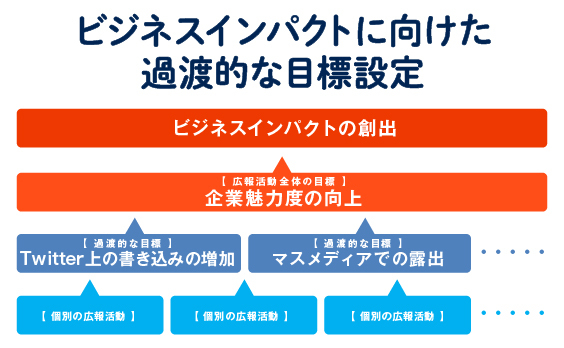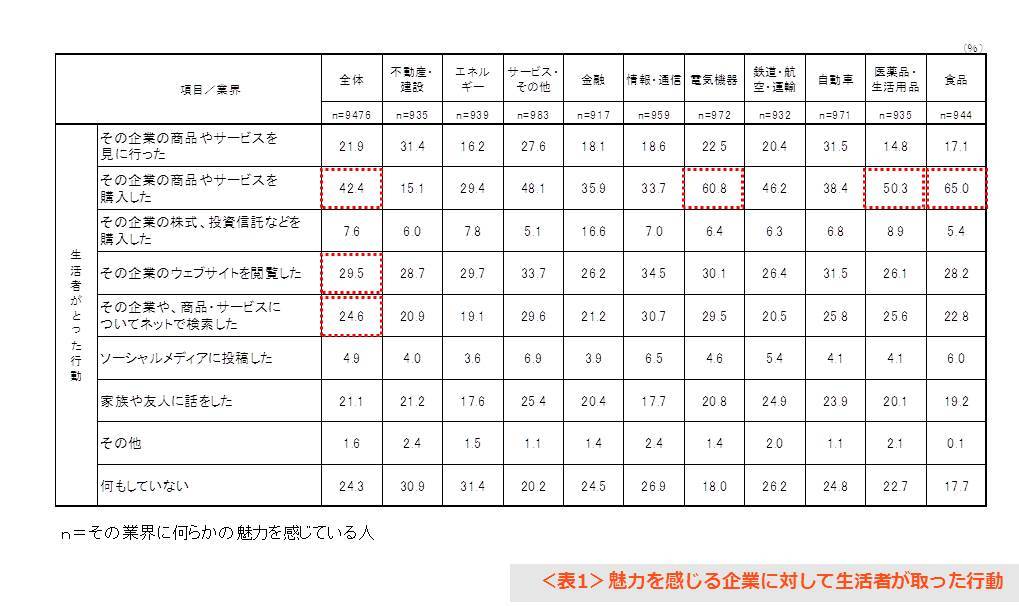The keyword for the fourth installment of the 'Corporate PR Strategy Institute' (within Dentsu Inc. Public Relations) series is "transitional goals." Transitional goals are intermediate targets set along the path toward the ultimate goal in PR—a concept I advocate. This time, I explain transitional goals that connect to measuring the corporate appeal and business impact generated by PR activities.
Point
Setting "transitional goals" is key to measuring the business impact of PR activities!
・Enhancing corporate appeal through PR activities also leads to business impact
・Consider daily PR activities and business impact measurement in two stages
・Finding those "transitional goals" is crucial!
Connecting PR Activities to Business Impact
"Does PR really drive business impact?"
This question has been asked time and time again in various contexts. Whether corporate PR activities like press releases and social media posts lead to increased sales of products/services and improved corporate profits, and how to measure that, is arguably the eternal theme of PR.
But here, I state it unequivocally.
PR does drive business impact, and there are ways to measure it.
The key lies in "setting transitional goals."
For example, a certain food company found a positive correlation between the increase in Twitter mentions about their company—regardless of whether they were related to their products—and the sales of their products at retail stores. In this case, "increasing Twitter mentions" becomes the intermediate goal.
Similarly, a membership-based web service company found a positive correlation between exposure in specific mass media outlets and membership growth. "Increasing exposure in specific mass media" becomes the transitional goal.
It's difficult to measure exactly how many press releases are needed to boost product or service sales, or what kind of social media posts will improve a company's revenue. However, by setting intermediate goals, it becomes possible to translate the impact of a PR initiative on one metric into another. For example, issuing a press release might increase metric A by 2 points, and a 2-point increase in metric A might then increase metric B by 1 point... and so on.
By setting and achieving these intermediate goals, daily PR activities can be effectively linked to business impact.

Corporate Appeal That Also Leads to Business Impact
One of the most plausible answers to the fundamental question of what the "overall" goal of PR activities is, is "enhancing corporate appeal." This makes sense, right? If we define the overall goal of PR activities as "enhancing corporate appeal," the "Corporate Appeal Survey" conducted by the Corporate PR Strategy Institute can serve as a useful metric.
This survey categorizes and analyzes the facts (the company's actions themselves and the resulting factual corporate components) that enhance corporate appeal into three areas: "Human Appeal," "Product Appeal," and "Corporate Appeal." It reveals which aspects of your company's appeal resonate with consumers and provides insights into the perspective needed for future PR activities to further enhance that appeal.
Furthermore, this "Corporate Appeal Survey" also investigates what kind of business impact (contribution to overall corporate activities) enhancing a company's appeal (the overall goal of public relations activities) brings.
The following data comes from the 2nd "Corporate Appeal Survey 2017" (Corporate Public Relations Strategy Institute) and shows "actions taken by consumers toward companies they find appealing."

This shows that increased corporate appeal often leads to product purchases or consideration.
Has appeal increased? "Interim goals" become metrics for daily PR activities.
Let's take the discussion a step further.
We set the overall goal of PR activities as "enhancing corporate appeal." We also identified methods to measure this. However, there is one problem here.
This goal and measurement method are too broad to effectively gauge the results of individual PR activities.
This is where setting "intermediate goals" becomes necessary.
The key point is that transitional goals and the overall goal do not necessarily need to be theoretically explainable. Setting transitional goals is sufficiently meaningful as long as their relevance can be recognized based on past data.
As the survey results you saw earlier clearly show that enhancing appeal leads to business impact, setting transitional goals that influence appeal enhancement allows individual activities aimed at those goals to connect enhanced corporate appeal with creating business impact.
I'm sure your company has examples where increased corporate website visits or clicks on Facebook page posts boosted appeal, and even led to business impact.
Journalist inquiries never cease, field requests for press releases come in constantly, and internal newsletter deadlines loom. Working amidst this chaos, it's easy to lose sight of why we're doing these things and what purpose each activity serves. Sometimes, higher-level objectives and lower-level objectives can even get mixed up.
By clearly defining the overall purpose, identifying the specific metrics (intermediate goals) that relate to it, and basing activities on these, you can avoid wasting resources and ensure work progresses appropriately.
Why not break free from PR efforts whose purpose is unclear right now? Aim for PR that enhances your company's appeal and contributes to the business impact that lies beyond.






